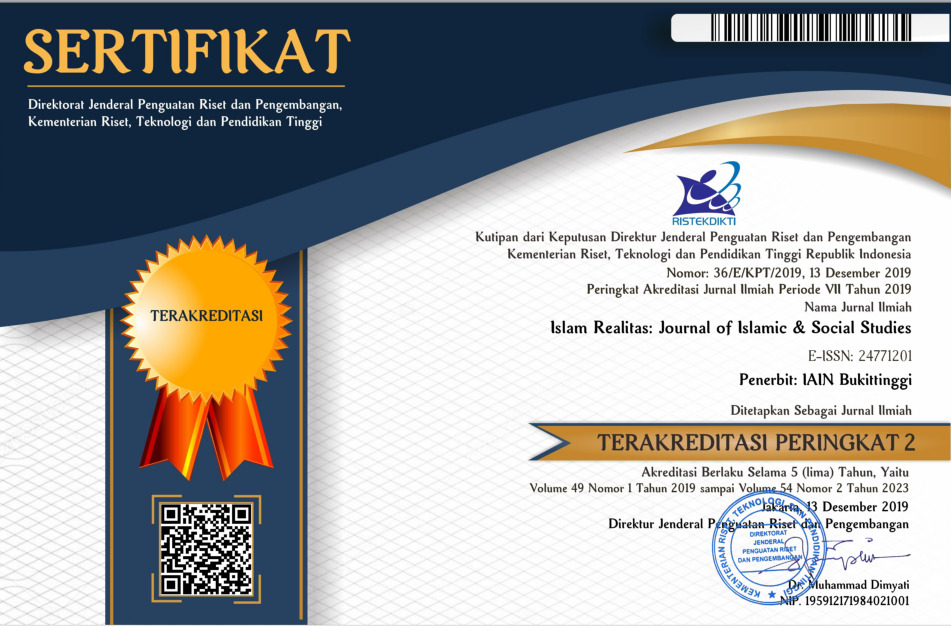Film Literacy and Sexual Desires of Female University Student at Pesantren in Madura, Indonesia
DOI:
https://doi.org/10.30983/fuaduna.v6i2.5591Keywords:
Sexual Desires, Feminist Studies, Film Literacy, Pesantren, Santriwati.Abstract
References
Abdul Rahman, Agus. “Perkembangan Seksual Santri Pada Pesantren Singel-Sex.†Psympathic: Jurnal Ilmiah Psikologi 1, no. 1 (February 26, 2018): 47–56. https://doi.org/10.15575/psy.v1i1.2118.
Bennet, Andrew and Royle Nicholas. Literarture, Criticism and Theory. London: Pearson, 2004.
Blackledge, C. The Story of V: A Natural History of Female Sexuality. New Jersey: Rutgers University Press, 2004.
Cocks, H. “Religon and Spirituality.†In Palgrave Advances in the Modern History of Sexuality, edited by H. Cocks and M. Houlbrook, 157–79. London: Palgrave, 2006.
Edgar, Andrew and Sedgwick Peter. Key Concepts in Cultural Theory. Edited by Andrew Edgar and Peter Sedgwick. London: Routledge, 2005. https://doi.org/10.4324/9780203981849.
Elise, Dianne. “Sex and Shame: The Inhibition of Female Desires.†Journal of the American Psychoanalytic Association 56, no. 1 (March 1, 2008): 73–98. https://doi.org/10.1177/0003065108315685.
English, Deirdre, Amber Hollibaugh, and Gayle Rubin. “Talking Sex: A Conversation on Sexuality and Feminism.†Feminist Review, no. 11 (1982): 40–52. https://doi.org/10.2307/1394826.
Freud, Sigmund. Three Essays on the Theory of Sexuality. Connecticut: Martino Fine Books, 2011.
Fromm, Erich. The Art of Loving. Jakarta: Gramedia, 2014.
Hurlock, Elizabeth. Psikologi Perkembangan: Suatu Pendekatan Sepanjang Rentang Kehidupan. Jakarta: Erlangga, 1980.
Mccann, Deirdre, International Labour, and Office Geneva. Conditions of Work and Employment Series No . 2 Conditions of Work and Employment Programme Sexual Harassment at Work: National and International Responses. Geneva: International Labour Organization, 2005.
Morokoff, Patricia J. “A Cultural Context for Sexual Assertiveness in Women.†In Sexuality, Society, and Feminism., 299–319. Washington: American Psychological Association, 1999. https://doi.org/10.1037/10345-012.
Munfarida, Elya, Siti Chamamah Soeratno, and Siti Syamsiyatun. “Truth and Love in Sexual Ethics of Islam.†KALAM 11, no. 1 (June 30, 2017): 1–30. https://doi.org/10.24042/klm.v11i1.1070.
Murchisson, J. M. Ethnography Essentials: Designing, Conducting, and Presenting Your Research. San Francisco: Jossey-Bass A Wiley Imprint, 2010.
Nashrullah, N. “Home: Khazanah.†Www.Republika.Co.Id, July 15, 2019. https://republika.co.id/berita/dunia-islam/islam-nusantara/19/07/15/puoh56320-santri-boleh-saja-akses-internet-tetapi-ini-syaratnya.
Oliver, Mary Beth, and Janet Shibley Hyde. “Gender Differences in Sexuality: A Meta-Analysis.†Psychological Bulletin 114, no. 1 (1993): 29–51. https://doi.org/10.1037/0033-2909.114.1.29.
Perez, M., and C. Saavedra. “Womanist and Chicana Feminist Methodologies.†In Transdiciplinary Feminist Research: Innovation in Theory, Method, and Practice, edited by A. C. Taylor and C. Hughes, 127. New York: Routledge, 2020.
Pfaus, James G, Sherri L Jones, Loretta M. Flanagan-Cato, and Jeffrey D Blaustein. “Female Sexual Behavior.†In Knobil and Neill’s Physiology of Reproduction, 2287–2370. Elsevier, 2015. https://doi.org/10.1016/B978-0-12-397175-3.00050-8.
Pribadi, Yanwar. “Religious Networks in Madura: Pesantren, Nahdlatul Ulama and Kiai as the Core of Santri Culture.†Al-Jami’ah 51, no. 1 (2014): 1–32. https://doi.org/10.14421/ajis.2013.511.1-32.
Shim, Young-hee. “Feminism and the Discourse of Sexuality in Korea: Continuities and Changes.†Human Studies 24, no. 1/2 (2001): 133–48. http://www.jstor.org/stable/20011307.
Suter, Elizabeth A., and Paige W. Toller. “Gender Role and Feminism Revisited: A Follow-Up Study.†Sex Roles 55, no. 1–2 (December 6, 2006): 135–46. https://doi.org/10.1007/s11199-006-9065-4.
White, Jacquelyn W., Barrie Bondurant, and Cheryl Brown Travis. “Social Constructions of Sexuality: Unpacking Hidden Meanings.†In Sexuality, Society, and Feminism., 11–33. Washington: American Psychological Association, 1999. https://doi.org/10.1037/10345-001.
Zolfagharkhani, M., and H. Ramezani. “‘Gaze’ and ‘Visuality’ in Jane Austen’s Pride and Prejudice.†Kata 14, no. 1 (2012): 1–5. https://doi.org/10.9744/kata14.1.1-6.
Downloads
Published
How to Cite
Issue
Section
Citation Check
License
Copyright (c) 2022 Zakiyatul Mufidah Mufidah

This work is licensed under a Creative Commons Attribution-ShareAlike 4.0 International License.
Authors who publish with this journal agree to the following terms:
- Authors retain copyright and grant the journal right of first publication with the work simultaneously licensed under a Creative Commons Attribution-ShareAlike 4.0. that allows others to share the work with an acknowledgment of the work's authorship and initial publication in this journal.
- Authors are able to enter into separate, additional contractual arrangements for the non-exclusive distribution of the journal's published version of the work (e.g., post it to an institutional repository or publish it in a book), with an acknowledgment of its initial publication in this journal.
- Authors are permitted and encouraged to post their work online (e.g., in institutional repositories or on their website) prior to and during the submission process, as it can lead to productive exchanges, as well as earlier and greater citation of published work (See The Effect of Open Access).





